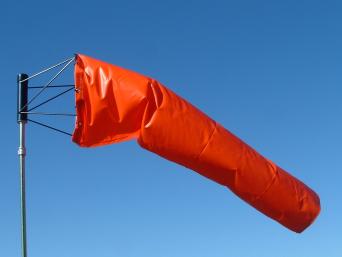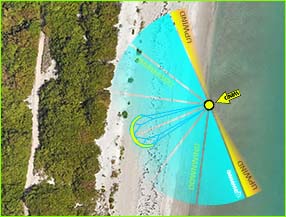Location:
 Any location with consistent, steady side-onshore winds (10 to 35+ knots), large open bodies of water and good launch areas is suitable for kitesurfing. Most kitesurfing takes place along ocean shores, usually off beaches, but it can also be practiced on large lakes and inlets and occasionally on rivers. Since kiteboarding relies heavily on favorable, consistent wind conditions, certain locations tend to become popular and sought out by kiteboarders.
Any location with consistent, steady side-onshore winds (10 to 35+ knots), large open bodies of water and good launch areas is suitable for kitesurfing. Most kitesurfing takes place along ocean shores, usually off beaches, but it can also be practiced on large lakes and inlets and occasionally on rivers. Since kiteboarding relies heavily on favorable, consistent wind conditions, certain locations tend to become popular and sought out by kiteboarders.You can cruise in wind as low as 5 knots with the equipment currently available on the market (large kite and large directional kiteboard). For jumping you may need around 7-8 knots.
To kitesurf, a kite, board, harness and other basic equipment is needed.
Tricks and Tips:
 Cross-shore and cross-onshore winds are the best for kiteboarding. Offshore winds pose the danger of being blown away from the shore in the event of equipment failure or loss of control. Offshore winds are suitable in a lake or when a safety boat is available, however they are generally more gusty. Direct onshore winds carry the risk of being thrown onto land, and are thus less favorable.
Cross-shore and cross-onshore winds are the best for kiteboarding. Offshore winds pose the danger of being blown away from the shore in the event of equipment failure or loss of control. Offshore winds are suitable in a lake or when a safety boat is available, however they are generally more gusty. Direct onshore winds carry the risk of being thrown onto land, and are thus less favorable.Always pump up your inflatable kite with it laid out completely. This will prevent the bladder from twisting inside the sheathing.
When winding up your lines on your controlbar, it is better to use a "figure 8" pattern rather than just looping them around the bar in a circle like on a spool. The figure 8 pattern helps prevent them from tangling when you unwind the lines before your next session.
Check your line lengths periodically. The kite lines tend to stretch over time, and new lines you buy on a spool will need to be pre-stretched. You can adjust the leader line knots to adjust for any changes.
Make sure your harness has a spreader bar that only detaches on one side. If you need rescue on the water, you can unhook your bar so its not in the way if you need to lie on your board and paddle into shore.
Instructional Video Starting with a Trainer Kite:
Kiteboarding can pose hazards to surfers, beachgoers, bystanders and others on the water. Many problems and dangers that may be encountered while learning kiting can be avoided or minimized by taking professional instruction through lesson centres. Kitesurfing schools provide courses and lessons to teach skills including kite launching, flying, landing, usage of the bar, lines and safety devices.
There weren't TVs. There weren't computers. Once upon a time, there weren't even radios. There are many alternative ways to do this. You could predict the weather yourself. Just using nature as a forecast, you could easily predict what weather was coming.
